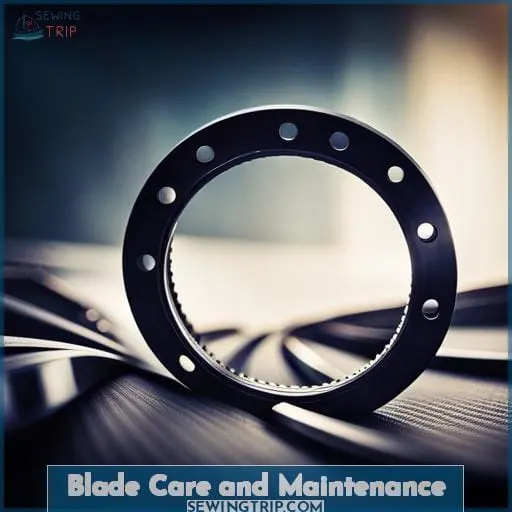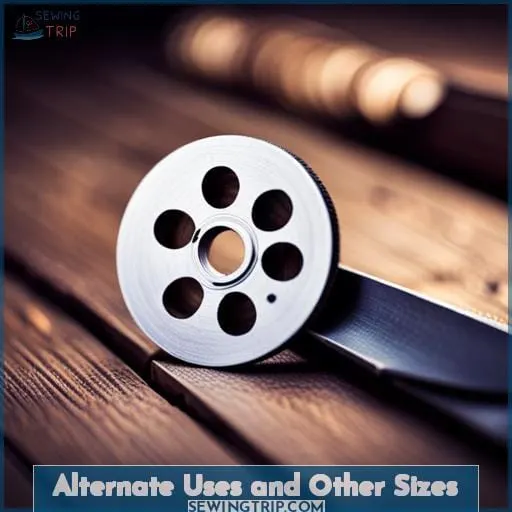This site is supported by our readers. We may earn a commission, at no cost to you, if you purchase through links.
 Ready to take your crafting projects to the next level? Choosing the right rotary cutter size is key to achieving precise cuts and mastering your sewing skills.
Ready to take your crafting projects to the next level? Choosing the right rotary cutter size is key to achieving precise cuts and mastering your sewing skills.
In this guide, we’ll explore the different sizes of rotary cutters available and their specific uses. From versatile 45mm cutters for all-around quilting tasks, to precise 28mm blades for intricate designs, and larger 60mm cutters for tackling big projects – you’ll find the perfect tool that matches your needs.
Get ready to unleash your creativity with confidence!
Table Of Contents
Key Takeaways
- A 45mm rotary cutter is the most popular size and versatile for all-around quilting tasks.
- A 28mm rotary cutter is a smaller size, precise for small cutting jobs.
- A 60mm rotary cutter is ideal for large projects and multiple layers of fabric.
- Use sharp blades for best results.
Choosing the Right Rotary Cutter Size
When choosing the right rotary cutter size for your projects, there are several factors to consider.
- The 45mm rotary cutter is a popular choice due to its versatility and ability to handle most quilting tasks.
- If you need precision for small cutting jobs, the 28mm rotary cutter is ideal.
- The 60mm size works best for large projects and cutting multiple layers of fabric.
Selecting the appropriate size will ensure efficient and accurate cuts in your sewing endeavors.
Factors to Consider
When selecting a rotary cutter size, consider:
- Project scope
- Material compatibility
- Cutting techniques
- Ergonomic considerations
- Your quilting expertise
The right blade size is crucial for safety and achieving precise cuts in your rotary cutting projects.
45mm Rotary Cutter for Versatility
You frequently need a versatile rotary cutter for your quilting projects, and the 45mm size is perfect for you.
Its ergonomic design ensures comfort during extended use, while its sharp blade effortlessly cuts through fabric layers.
Whether it’s fabric selection, cutting techniques, or maintaining your cutter’s efficiency, the 45mm rotary cutter has got you covered.
28mm Rotary Cutter for Precision
For precise cutting in your quilting projects, the 28mm rotary cutter offers exceptional accuracy and control.
It’s perfect for curved projects, intricate patterns, detailed appliques, small quilts, and fine cutting.
The 28mm size ensures that you can achieve the utmost precision in your sewing endeavors.
60mm Rotary Cutter for Large Projects
Transitioning from the precision of the 28mm rotary cutter, delve into the realm of larger projects with the 60mm rotary cutter—tailored for substantial fabric layers and expansive cuts.
Its benefits include:
- Efficient usage
- Handling challenges of intricate patterns
- A cutting capacity perfect for sizable quilting endeavors
Understanding Blade Options
Now that you have chosen the right rotary cutter size for your projects, it’s important to understand the different blade options available.
- Standard blades are widely used for general cutting tasks and are easily replaceable.
- Pinking blades provide a solution to prevent fabric fraying in crafting projects.
- Endurance blades offer a longer lifespan compared to standard ones.
- Additionally, there are blade sharpeners available for maintenance purposes to ensure your rotary cutter stays sharp and efficient.
Standard Blades for General Use
Now let’s delve into the different blade options available for general use, so you can make an informed decision when choosing a rotary cutter size.
When it comes to standard blades for general use, consider their:
- Sharpness
- Compatibility with various fabrics
- Cutting techniques they support
- How they contribute to quilting efficiency
Don’t forget about the importance of ergonomic handles for comfortable and safe handling.
Pinking Blades for Fraying Prevention
To prevent fabric fraying in your projects, consider using pinking blades with your rotary cutter.
| Blade Type | Function |
|---|---|
| Pinking | Prevents fraying by creating zigzag edges |
| Standard | General fabric cutting |
| Endurance | Longer blade lifespan |
| Sharpeners | Maintenance tools |
| Paper | Specific for paper crafting |
Blade maintenance is crucial for fabric preservation and crafting innovations.
Endurance Blades for Longer Lifespan
Extend the lifespan of your rotary cutter blades with endurance options, ensuring durability and extended use.
Implement longevity strategies, maximizing efficiency and durability for sustained performance across various quilting projects.
Incorporate blade maintenance for optimal durability and efficiency hacks for prolonged usability.
Blade Sharpeners for Maintenance
For maintaining sharpness, a blade sharpener is essential. It ensures prolonged usability and efficiency.
Consider DIY solutions or sharpening methods.
Prioritize blade care with maintenance techniques and safety precautions to master your craft while ensuring safety.
Proper Blade Replacement Procedure
When it’s time for a blade change in your rotary cutter, precision matters.
Unscrew the handle carefully, noting the washer’s orientation, and safely lift the blade with a tool.
Replace it snugly, ensuring the curve faces the nut, then dispose of the dull blade responsibly to keep your crafting safe and seamless.
Unscrewing and Disassembling
When replacing the blade on your rotary cutter, unscrew and disassemble the handle carefully to ensure a smooth transition.
- Verify nut orientation before disassembling.
- Use appropriate tools for safe blade removal.
- Handle with care to avoid accidents.
- Ensure proper disposal of dull blades.
- Prioritize blade safety throughout the process.
Replacing the Blade
To replace the blade on your rotary cutter, follow a precise and safe procedure for efficient maintenance and continued optimal performance.
- Unscrew the nut carefully, noting the washer’s orientation.
- Lift the handle, replacing the blade securely.
- Dispose of dull blades safely in DIY containers like repurposed metal cans, ensuring hazard prevention.
- Consider decorating for safer disposal or explore recycling options.
Safe Disposal of Dull Blades
Dispose of dull blades safely by following the proper blade replacement procedure.
Prioritize safe handling and recycling options.
Use DIY containers for disposal, ensuring safety precautions.
Implement techniques for safe handling and highlight recycling options for environmentally friendly disposal.
Consider DIY containers as a safety measure in proper blade disposal.
Blade Care and Maintenance
When it comes to maintaining your rotary cutter’s blade, maximizing its longevity is key.
Consider using a self-healing mat to preserve the sharpness of your blade, especially with tightly woven fabrics like batiks.
Additionally, keep an eye out for the features that Madam Sew’s cutters offer, designed with comfortable handles and secure grips for quilting precision.
Blade Longevity Tips
For optimal blade longevity, maintain your rotary cutter by following essential care and maintenance practices, like:
- Storing it properly
- Using sharp blades
- Cutting with the grain
- Avoiding fabrics that dull the blade
Using a Self-Healing Mat
Extend the longevity of your rotary cutter blades by utilizing a self-healing mat for blade care and maintenance.
A self-healing mat not only protects your fabric but also:
- Prevents blade dulling
- Reduces drag
- Prevents slipping while cutting
By using a self-healing mat, you can ensure that your blades stay sharp for longer, preventing accidents and ensuring smooth cuts every time.
Features of Madam Sew Cutters
With a comfortable grip and soft rubber, Madam Sew rotary cutters are a joy to use and highlight the importance of proper handling and safety.
| Feature | Benefit |
|---|---|
| Comfortable grip | Enhanced comfort and usability |
| Soft rubber | Secure handling |
| Symmetrical design | Suitable for both right and left-handed users |
| Specifically designed | For sewing and quilting artists |
| Easy-change system | Quick and convenient blade changes |
| Durable blades | Long-lasting and efficient |
Rotary Cutter Safety Tips
To ensure safe rotary cutter use,
- Always retract the blade when not in use
- Utilize any locking mechanisms provided
- Cut away from yourself
- Consider using Rotary Cutter Safety Gloves for added protection.
Retracting the Blade When Not in Use
In addition to blade care and maintenance, proper safety measures should be taken when using a rotary cutter, such as:
- Retracting the blade when not in use to avoid accidents, prevent cuts, and protect your fingers.
Using Locking Mechanisms
Utilize the locking mechanisms on your rotary cutter to prevent accidental blade activation.
- Lock the blade when not in use.
- Keep the blade guard in place when not cutting.
- Use hand protection, such as safety gloves, when handling the rotary cutter.
Cutting Away From Yourself
To ensure your safety, always cut away from yourself.
Use a mat to avoid cuts.
Practice with a dull blade.
Keep your blade sharp.
Maintain a consistent speed.
Using Rotary Cutter Safety Gloves
Consider using rotary cutter safety gloves for added protection when cutting with a rotary cutter.
- Reduce hand fatigue
- Provide increased control
- Prevent injuries
- Offer a comfortable grip
Alternate Uses and Other Sizes
When choosing a rotary cutter for your projects, it’s important to consider the size and type of fabric you’ll be cutting.
For small projects and intricate cuts, a 18mm or 28mm cutter is ideal.
For larger projects and multiple layers of fabric, a 60mm cutter is a good option.
You may also want to consider a separate cutter for paper, such as templates and swatch chips.
Separate Cutters for Fabric and Paper
In addition to safety tips, consider using separate cutters for fabric and paper to ensure precision in quilt piecing and reduce blade changes and downtime.
18mm for small projects
28mm for curves
45mm for versatility
60mm for thick materials.
Paper Blades for Templates and Swatch Chips
When working with paper, rotary cutters can be utilized for precise cutting of templates and swatch chips.
- Durable and long-lasting blades
- Affordable option for paper crafting
- Sharp edges ensure clean cuts every time
- Easy to use, making it a convenient tool for various projects
Efficient Rotation of Blades Between Projects
Rotating blades between projects:
- Ensures precision in quilt piecing
- Reduces downtime
- Prevents accidents
- Ensures precision
- Cuts through multiple layers
- Cuts thicker materials
Additional Safety Measures
Proper handling and a comfortable grip are essential for safe rotary cutting.
Madam Sew rotary cutters feature a soft rubber grip for secure handling and a symmetrical design that’s suitable for both right and left-handed users.
Proper Handling and Grip
When not in use, always retract the blade and store your rotary cutter in a safe place.
To ensure proper handling and grip, follow these additional safety measures:
- Keep the blade retracted when not actively cutting to prevent accidental contact with skin.
- Use safety gloves for added protection while using the rotary cutter.
- Avoid using dull blades as they can lead to accidents or uneven cuts.
- Store your rotary cutter in a safe place where it won’t be easily accessible to children or pets.
Taking these precautions will help you enjoy crafting with your rotary cutter safely and confidently!
Importance of a Comfortable Handle Design
In addition to proper handling and grip, a comfortable handle design is an important safety measure to consider when choosing a rotary cutter.
Ergonomic handles and straight handles provide comfort and durability, while ensuring safe use.
Symmetrical Design for Left-Handed Users
A comfortable handle design is also important for left-handed users, as a symmetrical design can help to prevent accidents.
When choosing a rotary cutter, consider these additional safety measures:
- Ergonomic handles provide a secure grip and reduce hand fatigue.
- Longer blade lifespan saves time and money on frequent replacements.
- Pairing with self-healing mats ensures longevity of both the blade and work surface.
Frequently Asked Questions (FAQs)
What is the difference between a rotary cutter and a circle cutter?
Rotary cutters are great for cutting fabric straight.
Circle cutters are perfect for making perfect circles.
What is the best rotary cutter for beginners?
A 45mm rotary cutter is a great option for beginners because it’s versatile and can handle most quilting tasks.
How do I know when it’s time to change my rotary cutter blade?
It’s time to change your rotary cutter blade when you notice:
- Spots in your cuts
- Having to press harder than usual
- Going over cuts multiple times
What are the different types of rotary cutter blades?
There are 4 different rotary cutter blade sizes:
18mm
28mm
45mm
60mm.
45mm is the most versatile size and suitable for most quilting tasks.
How do I care for my rotary cutter blade?
To care for your rotary cutter blade, remember to:
- Clean fabric dust around the nut and safety shield.
- Regularly change blades for safety and efficiency.
- Consider using a quick-change rotary cutter for easy replacement.
Conclusion
Now that you know what size rotary cutter blade you need, you can start cutting with confidence!
Be sure to read our other articles on rotary cutters for more tips and advice.













